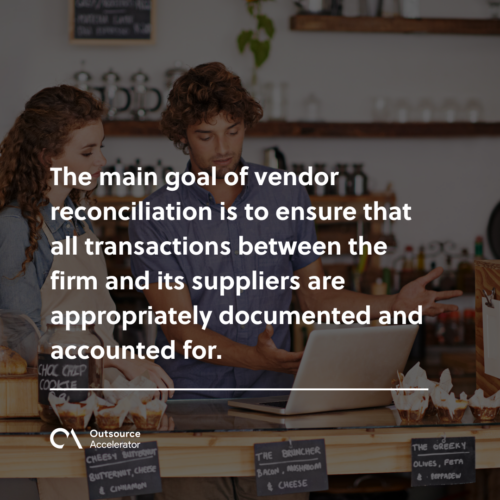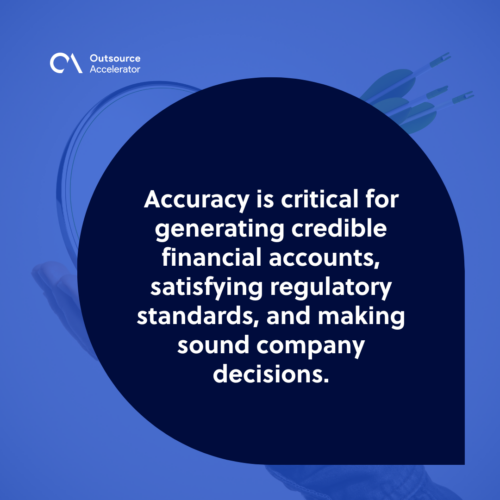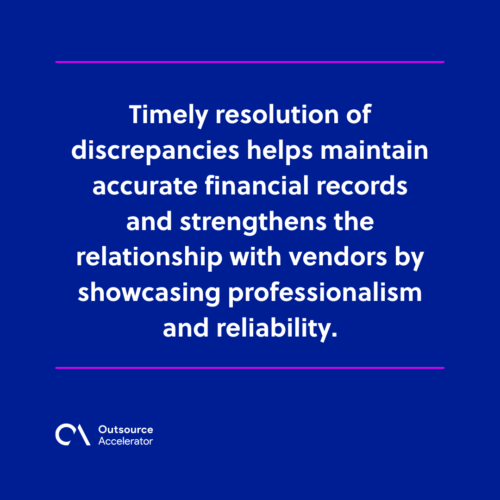Tips and best practices to streamline vendor reconciliation

Having different suppliers and making payments to them comes with running a business.
Before any payments, the team in charge of accounts payable performs vendor reconciliation to check and ensure that the correct amount is being charged to the vendor or supplier.
But how exactly does this procedure function?
This article discusses vendor reconciliation, including some tips and best practices for a more efficient process.
Vendor reconciliation is an accounting procedure that compares a company’s financial records with the invoices and other transaction-related papers obtained from suppliers. It aids in preventing data input errors and fraud.
By comparing vendor invoices with the company’s internal records, the following discrepancies can be identified and fixed:
- Improper pricing
- Duplicate bills
- Missing payments
It is an essential checkpoint to guarantee financial data integrity. The main goal of vendor reconciliation is to ensure that all transactions between the firm and its suppliers are appropriately documented and accounted for.
Adopting this to the firm’s transaction process will help ensure all payments are completed before the deadline.

Steps involved in the vendor reconciliation process
Vendor reconciliation is a continuous procedure rather than a one-time application. To maintain current financial records, regular monitoring and data validation are necessary.
This process is crucial for companies with many vendors or transactions since it helps avoid financial errors that might have serious repercussions.
Here are the following processes involved in vendor reconciliation:
Gathering vendor data
Gathering vendor data is a fundamental step in vendor reconciliation. It involves collecting all relevant documents from your vendors, such as:
- Invoices
- Statements
- Purchase orders
This data is essential for comparing and reconciling transactions with your financial records.
A centralized system or database is essential to gather data efficiently. It allows you to access and retrieve the necessary documents easily when needed.
Moreover, maintaining a well-organized repository can save time and effort searching for specific invoices or statements.
Verifying vendor invoices
Once you have gathered the necessary vendor data, verifying the vendor invoices’ accuracy is the next step.
This involves carefully reviewing each invoice to ensure it aligns with the goods or services received from the vendor.
You must compare the invoice details, such as product descriptions, quantities, prices, and other applicable discounts or rebates, with the corresponding purchase orders and receipts.
In cases where invoices are received electronically, leveraging optical character recognition (OCR) technology can streamline the verification process.
OCR software can automatically extract relevant information from electronic invoices, enabling faster and more accurate verification.
Matching payments
This is where vendor payments are compared with the corresponding invoices, ensuring that all payments are accurately recorded and accounted for.
You must cross-reference payment details, such as check numbers, transaction dates, and amounts, with the invoice information to match payments.
Matching payments guarantees that each payment has been correctly allocated to the appropriate vendor and invoice.
It not only helps maintain accurate financial records but also aids in identifying any discrepancies or errors in the payment process.
In this vendor reconciliation step, it lets you detect instances of overpayment, underpayment, or missed payments, which can have significant financial implications for your business.
Comparing accounts
Comparing accounts helps identify any discrepancies or errors in the vendor’s account or your financial records.
You must reconcile the vendor’s opening balance, invoices, payments, and any outstanding credits or debits to compare accounts.
This step involves reviewing each transaction and confirming its accuracy and completeness.
Doing so ensures your account balance accurately reflects the transactions that have taken place between your organization and the vendor.
Investigating discrepancies
It is not uncommon to encounter discrepancies or errors during the vendor reconciliation process.
This step is critical in maintaining accurate financial records and resolving any issues that may arise. Investigating discrepancies includes the following:
- Contacting the vendor for clarification
- Reviewing supporting documentation (purchase orders, receipts, or shipping records)
- Conducting internal audits to trace the transaction flow
Promptly contacting the vendor to discuss the discrepancy and requesting any necessary documentation or information can help expedite the resolution process.
Importance of vendor reconciliation for businesses
By meticulously comparing vendor statements with the accounts payable ledger, discrepancies can be promptly identified and resolved.
Vendor reconciliation is critical for firms for the following reasons:
Accurate and complete financial records
Businesses can determine and correct anomalies or errors by reconciling vendor invoices, payments, and accounts with internal data.
Accuracy is critical for generating credible financial accounts, satisfying regulatory standards, and making sound company decisions.
More so, maintaining correct vendor data allows organizations to negotiate better terms with vendors, uncover cost-cutting possibilities, and efficiently manage working cash.
By comparing vendor statements with bank statements and financial reports, businesses can ensure that all transactions are accounted for and discrepancies are promptly addressed.

Cost control and cash flow management
Vendor reconciliation aids in cost control and cash flow management. By reconciling invoices and payments, businesses may guarantee that they pay vendors properly and on schedule.
Organizations must maintain excellent vendor relationships to ensure a seamless supply chain and access to high-quality goods and services.
Professionalism, dependability, and openness in financial dealings are demonstrated through timely and correct reconciliation.
By reconciling vendor accounts and meticulously comparing vendor statements with company records, discrepancies like unpaid invoices can be identified and rectified promptly.
It helps develop trust and credibility—enhancing collaboration, communication, and business conditions.
Fraud prevention
Vendor reconciliation is vital in the discovery and prevention of fraud.
Businesses can detect inconsistencies or suspicious activity by thoroughly inspecting vendor invoices, payments, and accounts.
It allows businesses to reconcile vendor statements with internal records, thereby minimizing the risk of duplicate payments and ensuring that all invoices are accounted for accurately.
The timely identification of fraudulent transactions helps mitigate financial risks, it also protects the firm’s assets and maintains a safe financial environment.
Analyzing the vendor’s statement can also help in identifying errors and resolving any issues promptly, ultimately maintaining strong vendor relationships and financial integrity within the organization.
Vendor reconciliation: Tips and best practices
Vendor reconciliation is a critical process that requires attention to detail and effective management.
By implementing the following tips and best practices, businesses can streamline vendor reconciliation efforts and maintain accurate financial records.
Maintain accurate vendor records
As mentioned, it is crucial to maintain accurate vendor records to ensure smooth vendor reconciliation. Regularly update vendor information, such as:
- Contact details
- Payment terms
- Tax identification numbers
Businesses can avoid data duplication or missing reports by keeping vendor records updated.
Organizing and retaining all relevant vendor documents, such as invoices and purchase orders, is key for comprehensive vendor reconciliation.
Regular vendor statement reconciliation is another crucial tip to uphold. By comparing vendor statements with your own records, discrepancies can be quickly identified and resolved.
Regularly update purchase and payment data
Timely and accurate purchase and payment data recording is essential for effective vendor reconciliation.
Businesses should establish a systematic payment process to update their financial records regularly.
This practice minimizes the risk of anomalies and ensures reconciliation is based on the most recent data.
Implement robust bookkeeping software
Utilizing robust bookkeeping software can significantly streamline the vendor reconciliation process. Modern accounting software often has these features specifically designed for reconciliation:
- Automated matching of invoices and payments
- Customizable reports
- Real-time data synchronization
Boomering is a trusted offshoring provider that utilizes bookkeeping software to simplify the reconciliation process, reduce manual effort, and enhance accuracy.
Conduct periodic audits
Periodic audits of vendor records and reconciliation processes help identify accounting deficiencies.
Businesses should perform regular internal audits to review vendor data, reconcile accounts, and ensure compliance with financial policies and procedures.
Audits provide insights into areas that may require improvement, allowing businesses to address issues proactively and maintain robust vendor reconciliation practices.
Establish clear communication channels with vendors
Effective communication channels ensure that officers in the vendor reconciliation process can promptly address discrepancies or questions regarding financial matters.
Additionally, regularly engaging with vendors helps build strong relationships, resolves issues efficiently, and fosters cooperation during the whole reconciliation process.
Document the reconciliation process
Documenting the vendor reconciliation process is crucial for consistency and reference purposes.
A documented process ensures that all team members follow the same procedures and can refer back to guidelines whenever necessary.
A well-documented reconciliation process may also help train new employees to expedite an excellent vendor reconciliation process.
Interns or new employees can use the documentation as their reference or guide.
Resolve discrepancies promptly
Timely resolution of discrepancies helps maintain accurate financial records and strengthens the relationship with vendors by showcasing professionalism and reliability.
Promptly investigating and resolving discrepancies minimizes disruptions, reduces financial risks, and ensures the integrity of the vendor reconciliation process.
Establishing a clear vendor reconciliation workflow can streamline the process and prevent errors in financial reporting.
Keeping track of credit notes and applying them correctly in the reconciliation process is vital for accurate accounts payable.

Automate the reconciliation process
Leveraging automation tools and technology can significantly streamline the vendor reconciliation process.
Streamlining any financial transaction is critical as it guarantees the correctness and dependability of financial records.
Businesses may reduce mistakes, conflicts, and inconsistencies in their financial data by simplifying transactions.
In addition, financial transactions that are streamlined improve efficiency and productivity.
This saves time and money by eliminating human errors, redundant processes, and inefficient workflows.
Automated reconciliation software can match invoices, payments, and accounts more efficiently, reducing manual effort and minimizing the risk of errors.
You may use any of the following automated accounting software:
- QuickBooks
- Xero
- SAP Ariba
- Sage Intacct
- NetSuite
- KashFlow
These tools help businesses by providing real-time data synchronization and customizable reports.
Maintain a systematic documentation process
Maintaining a systematic documentation process for vendor reconciliation ensures that all relevant documents are easily accessible when needed.
A well-organized documentation process also facilitates audits and helps businesses demonstrate compliance with regulatory requirements.
Vendor reconciliation maintains accurate financial records
Vendor reconciliation is a critical task that ensures accurate financial records for businesses.
Organizations can maintain a healthy vendor relationship by following the tips and best practices discussed above.
Keep in mind a well-managed reconciliation process contributes to the business’s overall financial health and ensures compliance with financial regulations.







 Independent
Independent




